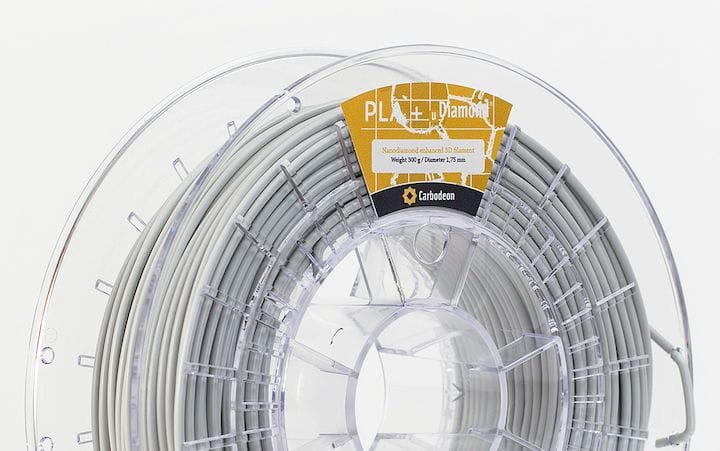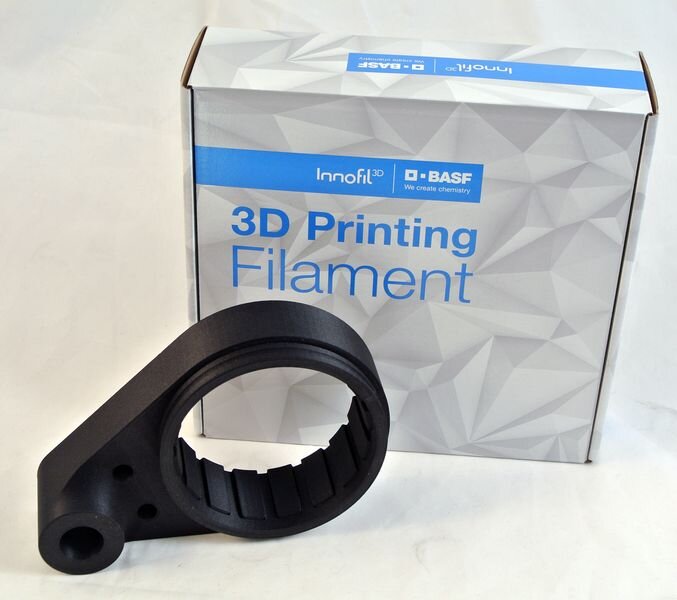![A spool of diamond-infused 3D printer filament [Source: Carbodeon]](https://fabbaloo.com/wp-content/uploads/2020/05/image-asset_img_5eb09c40a9435.jpg)
A company is marketing a “diamond” 3D printer filament.
When I first caught notice of this, I had visions of a crystalline filament of incredible strength and wondered how on Earth it could ever be extruded. But, after shaking my head a bit I read further and discovered the truth about this unusual material.
The product is uDiamond PLA from Carbodeon, based in Vantaa, Finland. The company has apparently been around since at least 2006, and has spent considerable time developing their unusual material, uDiamond.
This is a composite material, much like other filament makers have produced by mixing a substance with PLA. We’ve seen composite materials made from mixes of wood particles, steel, copper, bronze, carbon fiber, bamboo, algae and even coffee. The idea is to leverage the excellent 3D printing operational properties of PLA, while absorbing some new characteristics from the added material.
The metal composites result in objects that seem quite metallic — and are heavy. The wood composite filaments produce objects that can be processed much like actual wood, including sanding, drilling, etc. The algae filament produces green prints and emits a foul aroma during printing.
Now there’s a diamond filament. What exactly is it? Carbodeon explains:
“Carbodeon uDiamond PLA (polylactic acid) is a high-performance diamond enhanced 3D printing filament. It contains functionalized nanodiamond particles.”
Aha. It seems they are producing nanoparticles of diamond, but making them in a functional shape: a sphere. These would be mixed with the PLA in a particular ratio. But what benefits does this provide? Do you get clear, twinkly prints?
No, it appears you receive some interesting engineering properties, including:
-
The spherical diamonds act as a lubricant during printing, allowing extremely rapid print speeds of up to 500mm/s, far faster than most 3D printers can manage
-
Improved rigidity and strength as the diamond particles reinforce the PLA microstructures
-
Improved thermal conductivity, making it easier to heat up, and provide this feature if desired in prints
The material’s thermal characteristics are a bit different from normal PLA, which tends to 3D print well at temperatures ranging from 185C-210C. Meanwhile, they list operating temperatures for uDiamond as 220C-250C, which must be the highest operating temperature I’ve yet seen for a PLA-based material.
In addition to those properties, the normal PLA attributes of biodegradability, low toxicity and easy printing are still present in the uDiamond material.
One question I immediately came upon was the cost of the diamond filament. In my experience, if anything has diamonds in it, it costs a huge amount. Is this the case with uDiamond? It turns out not so.
Carbodeon sells uDiamond filament in three spool sizes: 500g, 1000g and 2300g, with prices ranging from €35 (US$40) for the 500g to €135 (US$152) for the large 2.3kg spool. That’s not unreasonable and may say something about the diamond ratio and value of the microscopic diamond nanoparticles.
If you’re looking for an unusual high-speed filament, uDiamond could be it.
Via Carbodeon











An inventive designer has developed a method for producing 3D paper objects using recycled paper and 3D printed molds.